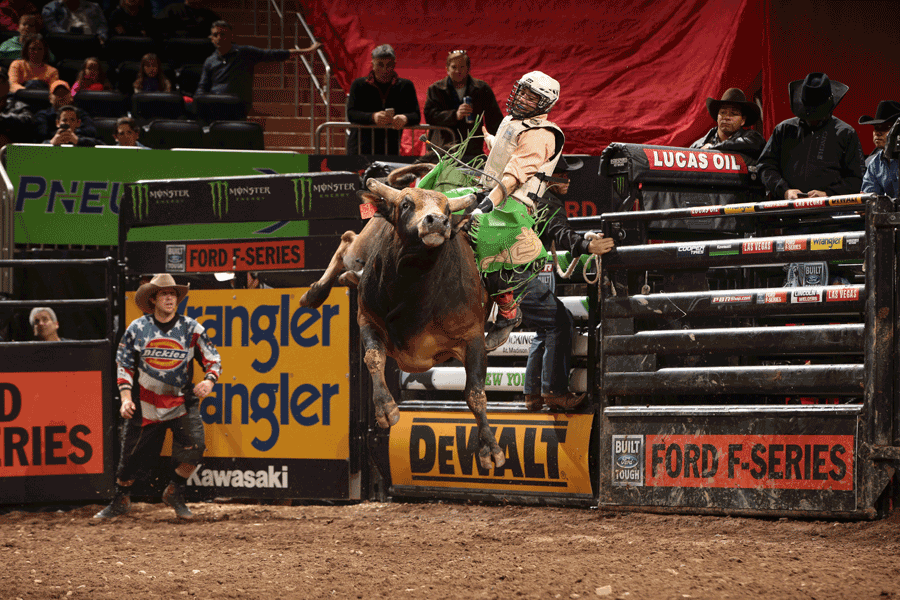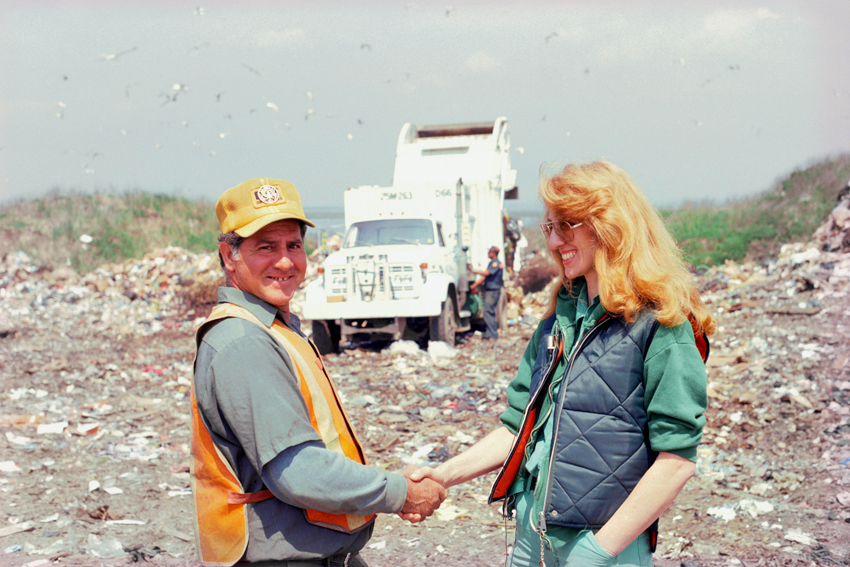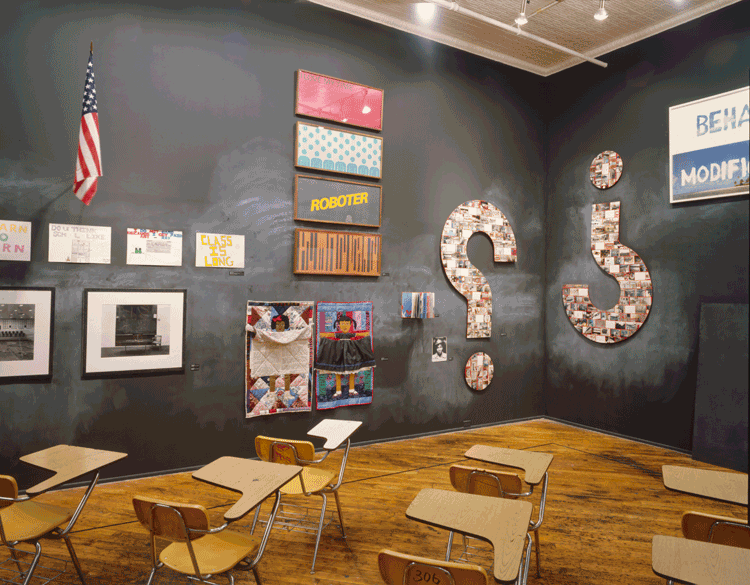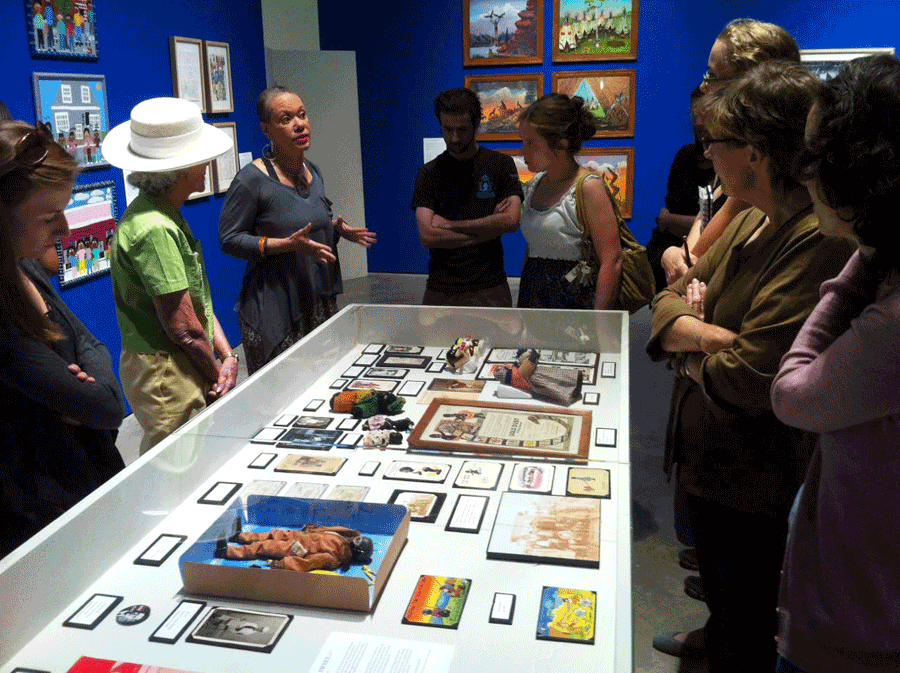“I know what this is: it’s America,” I joked to my friend as the jumbotron at Madison Square Garden displayed mountain streams, hay bales in the backs of trucks, notable bridges and radiant wheat threshers mowing a field at the golden hour. As if to confirm my comment, the leathery face of a young cowboy appeared onscreen and solemnly delivered his only line: “America”. Yes, any suspicions the crowd might have had were calmed, and we could now take comfort in the spectacle of our country’s splendour – eyes welled and sparkling with tears. A symbol of earnestness, the cowboy’s tone of voice – reverently plainspoken, with a twang of downhome confidence – sanctified the beatific video, largely depicting pastoral themes such as family and farming. The conflation of the military with social service, however, is the hallmark cliché of this brand of America: and so a soldier’s homecoming cuts to teachers in the classroom, cuts to Border Patrol agents monitoring a dusty stretch of border wall, cuts to ER doctors, cuts to… Almost everyone is white; if there’s a person of colour, he or she wears a uniform; if there’s a woman, she’s a teacher, nurse or mom. Ordinarily I’d hear the word ‘America’ as a derisive belch when someone in my bubble made fun of some redneck shit. Tonight, at the Professional Bull Riders event, a nationally-touring competitive bullriding circuit, I was told to “go to hell, motherfucking redneck” by a group of animal rights protesters outside. “It’s been a while since I got called a redneck,” one of my Southerner friends said as we entered.
Tonight, at the Professional Bull Riders event, a nationally-touring competitive bullriding circuit, I was told to “go to hell, motherfucking redneck” by a group of animal rights protesters outside
The PBR is a microcosm of an American mythology: for all its evocation of country, it’s an arena full of dirt that links national identity to the blunt spectacle of competitive cowboying – pay attention, though, the typical ride is less than eight seconds long, at which point a rider eats dirt. Yet, at this event, half the riders were Brazilian, Argentinian or Mexican; the remaining, branded ‘Our Heroes’, were from Montana, North Carolina, Missouri, Texas and various other states with high land-per-capita ratios. All their tengallon hats conjure a scene of a cowboy surveying his herd as he leads the animals from pasture to sale and slaughter. Out of place within the urban stadium, the dirt nonetheless conjures American pastures. It’s about land, and the years of violent spectacle that rendered it the testing ground for – or natural home to – rugged individualism and the outlaw’s self-determined moral compass. America, a killer metaphor. God, and so lonely.
As the story goes, Joseph Beuys liked America. And if we take the artist on his word, America liked him back. Or so he says – it’s difficult to confirm 100 percent. If we look closely at the story, he visited America twice in 1974. There was the long weekend they had together during the performance I Like America and America Likes Me, in which the artist was carted from the airport to New York’s René Block Gallery, where he spent three days with a coyote, and then was returned to the airport via ambulance. That fling is based on an ‘America’ of the Wild West, involving the animal that serves as Native American symbol of the wily trickster and friend in the dark.

Earlier that year, however, Beuys made an overture to the US with Energy Plan for the Western Man, a lecture tour that visited New York, Chicago and Minneapolis college campuses. Against the growing disillusionment of the Vietnam era – what the artist called an ‘energy crisis’ – he proposed social sculpture (not everyone loved it). The medium staged society as an artwork, to which everyone contributed through conscientious actions. Collaboration with social and physical sciences propelled art to the spiritual core of democratic society, and, marrying activism to mythology, Beuys viewed public institutions – artworks, political parties, universities – as the byproduct of personal intensity of purpose, meaning and spirit. Does Beuys’s social sculpture seem compatible with the cowboy, though? The cowboy’s moral universe fortifies the world he carves out of the vast nothingness of the plains, jiving with the wilfulness of the artist’s model. But the de facto collectivist contradicts the American notion of choice that underwrites political participation in this country: living by his own rules, an outsider, the cowboy can always opt out. It’s this contradiction that makes negotiating social sculpture in the US so challenging.
“Mamas, don’t let your babies grow up to be cowboys,” Willie Nelson and Waylon Jennings cajolingly sang, calling out the romantic self-indulgence of life on the range. The ‘Outlaw Country’ stars exemplify the cowboy as witty iconoclast: their urbane observation is emblematic of a split between city and country. The PBR, however, is a reminder that the live-free-or-die spirit also aligns with self-serious social conservatism. A Christian prayer, an uncommon practice in New York public events, introduces the event celebrating man’s triumph over beast; and even this rugged sport has been instrumentalised by copious sponsorship and product placement (the Ford truck sideshow was especially boring). This contradiction clings to the cowboy like another sponsorship patch on his vest.
The conflict represents the allure of American spectacle: violence fills seats, and offers an antidote to alienation. It is also similar to Beuys’s ‘energy crisis’, which, during the 1960s and 70s, American artists sought to engage, challenge and cure. In Mierle Laderman Ukeles’s MANIFESTO FOR MAINTENANCE ART 1969!, she writes, ‘I am an artist. I am a woman. I am a wife. I am a mother. (Random order) I do a hell of a lot of washing, cleaning, cooking, renewing, supporting, preserving, etc. Also, (up to now separately) I “do” Art. Now I will simply do these everyday things, and flush them up to consciousness, exhibit them, as Art.’ The document revolutionarily shifted the focus of art from the production of objects to the provision of care, and emphasised Ukeles’s role within a wider social ecology of family or the art community. Whereas Beuys depended on shamanistic benevolence, Ukeles’s pragmatic humanism sought to make the actual labour of community and institutions visible, dramatising it in her performances of sweeping, dusting and mopping, or her ongoing residency, begun in 1978, at the New York Department of Sanitation, where she shook the hand of every sanitation worker, insinuating art into local bureaucracy.

Cowboys, it could be assumed, are the type of people who give too-hard handshakes, but for Ukeles, it is a much more revealing and vulnerable gesture that embraces the hand sullied by its labour. What effect do these politics of work have on social sculpture in America? Though somewhat less alchemical, Ukeles nonetheless made invisible labours visible, charging them with meaning. It is also inspiring, because it does not start from an institutional position to begin with, but rather originates in the artist’s home, reflecting an enterprising homesteading that paralleled the cowboy on the frontier. Beuys’s notion that ‘everyone is an artist’ begins to reflect its socialist democratic underpinnings. A university education is expensive, and many students incur gross amounts of debt; state-provided healthcare, gone. Though public institutions appear chiefly inaccessible, a down-for-the-scene mentality of DIY community-building runs through American social sculpture. FOOD, a restaurant cofounded by artists Carol Goodden, Tina Girouard and Gordon Matta-Clark in New York in 1971, straddled the line between entrepreneurship and artwork. Employing artists, and coproducing a place to meet and talk, FOOD intertwined service labour with the production of community and discourse – similar projects have sustained artist communities throughout the US, and have been a touchstone of alternative scenes, bright burning in often transient nodes of youth culture like Baltimore, Providence, Portland, Oakland, Los Angeles and others.
‘Creativity is common’, is writer, historian and publisher Ishmael Reed’s more pragmatic perspective to ‘everyone is an artist’. For Reed, this idea led to his research into black spiritual traditions during the 1960s. Originating in West Africa, and persisting through slavery and segregation, these traditions became foundational to Reed’s depictions of multiculturalism, and his satire of American culture, the novel Mumbo Jumbo (1972), wherein black culture is a virus spread through dance. In a recent interview with The Paris Review, Reed tellingly describes how he fed his MacArthur ‘genius grant’, worth over half a million dollars, back into the production of an opera and other publishing projects, stating, ‘You just want to use up whatever equipment you can get… I said thousands of people would benefit if I ever got one of those grants, and, you know, thousands have.’ Reed, who early in his career was at the forefront of Black Nationalism, provides a go-for-broke model of cultural resistance in the form of localised institutions and publishing – he anthologised one-time poets and workers’ prose; collected and wrote blues songs and wrote black cultural histories; not to mention his own poetry and prose. As the long list of his various print-based projects indicates, it’s important to commit these things to print. Small-scale projects, like the volatile communities they serve, don’t have to last forever, and they probably shouldn’t. The comfort lies in the urgency of the work.

Many of Reed’s activities predate or were contemporaneous with those of Beuys; this was a period when the relationship between an artist or the community and the art institutions that host them in turn became more contentious. In the 1980s, artists Julie Ault, Patrick Brennan, Beth Jaker, Mundy McLaughlin, Marybeth Nelson, Tim Rollins and Peter Szypula – later joined by Felix Gonzalez-Torres – founded Group Material, and opened a storefront gallery in the East Village. Opposing the art market’s ascendant influence, they collaboratively presented exhibitions that historicised the issues facing their immediate community, such as the AIDS crisis, and hosted talks and town halls. The exhibition was the medium through which Group Material spread authorship, and made the organisation inclusive to artists and nonartists alike; their activist iconoclasm cues us into the discursive space they’re trying to create, and undercuts its grandiosity. More than Beuys, who embraced spectacle as commensurate with his mythological tone, Group Material challenged this spectacle – though radical histories and activism appear in both projects, and the Free International University that Beuys founded was one of the groups from which Germany’s Green Party emerged.
It’s worth restating: creativity is common. But leaping forward from Group Material to today, the localisation of an art practice has come increasingly under fire through rising rents in cities like New York; artists are also acutely aware of their role in gentrification. Artists like Harrell Fletcher, with his softened brand of social practice, turned to the university as host, founding the Art and Social Practice Program at Portland State University (of which I was a student). Fletcher’s projects – such as pre-YouTube user-generated-content platform Learning to Love You More, a collaboration with Miranda July, which prompted participants to ‘Feel the news’ or ‘Make an encouraging banner’ and upload their responses; The People’s Biennial, cocurated with Jens Hoffmann, which presented 25 artists from Portland, Rapid City, Winston-Salem, Scottsdale and Haverford – all supposed nonart centres; and The American War, a recreation of a Vietnamese war museum that toured throughout the US and hosted talks with scholars and veterans – have a commonsense appeal, offering accessibility in lieu of critique. At the same time, it’s a suburbanisation of social sculpture that flattens the antagonism a community depends on for vitality, a kind of white flight back to the institution that bolsters its authority, and ability to stage community as a spectacle.

In the end, it’s a question of scale, and many institutions are seeking to promote regionality and small-scale projects under their financial umbrellas. The situation is dire, as government funding has eroded over the last 30 years, with only a handful of artist-initiated foundations keeping the majority of nonprofits alive. In December it was reported that Rocky star Sylvester Stallone was being considered for head of the National Endowment for the Arts. What is also especially important to consider about this type of aid is these organisations’ insistence on funding projects throughout the whole of the US, and at the micro level, as with the Precipice Fund, a regranting programme that provides organisations in several American cities with funds to distribute to local projects throughout the year. These projects likely won’t last very long, but it’s for their incipient quality and often-youthful exuberance that they challenge the monolithic consolidation of resources necessary to found an institution.
One such project is Home School, an informal art school started in the Portland garage of manuel arturo abreu and Victoria Anne Reis, funded by the Precipice Fund via the Portland Institute for Contemporary Art. The project offers a range of events, from karaoke therapy to Skype lectures and other forms of public and personal activism. For its scale and informality, and the fact that it’s run by young people, Home School demonstrates that social sculpture continues to find a place within the US as an agile organisation to resist and respond to privatisation. An organisation like Home School, based on documentation, also hosts healthy antagonism. Winslow Laroche, an artist whose work spans painting to discursive trolling, delivered an artist Skype talk critiquing the white cube and other institutional models that exploit artists of colour, and subsume them under a bland market share. “Art is not a way to make money,” he reminds us, before telling us to go be a financial analyst. Home School challenges the monolithic institutional spectacle that has come to define social sculpture in the US. But Beuys and his legacy is actually parked in the garage. It just never stays parked for long.
From the March 2017 issue of ArtReview
